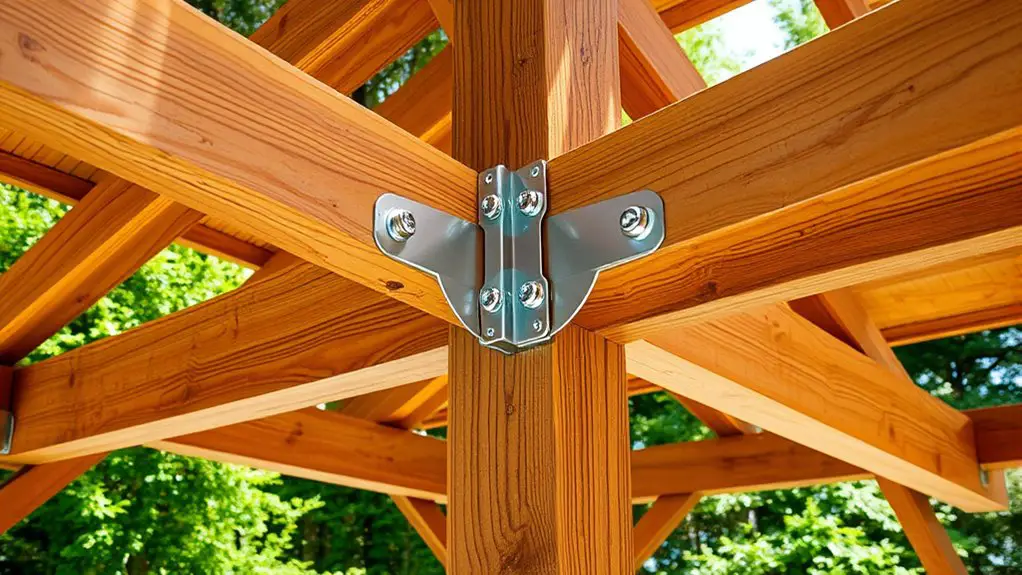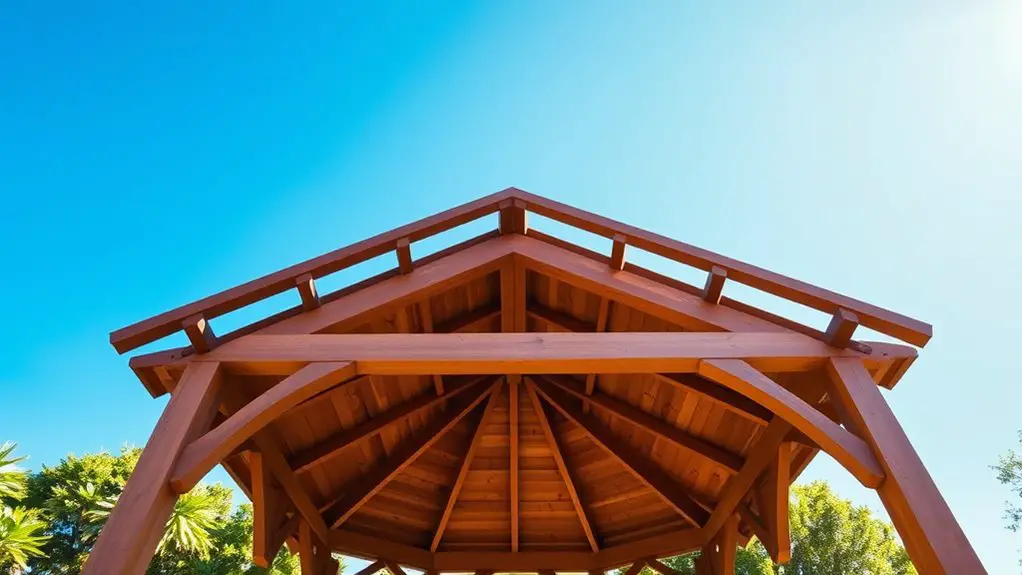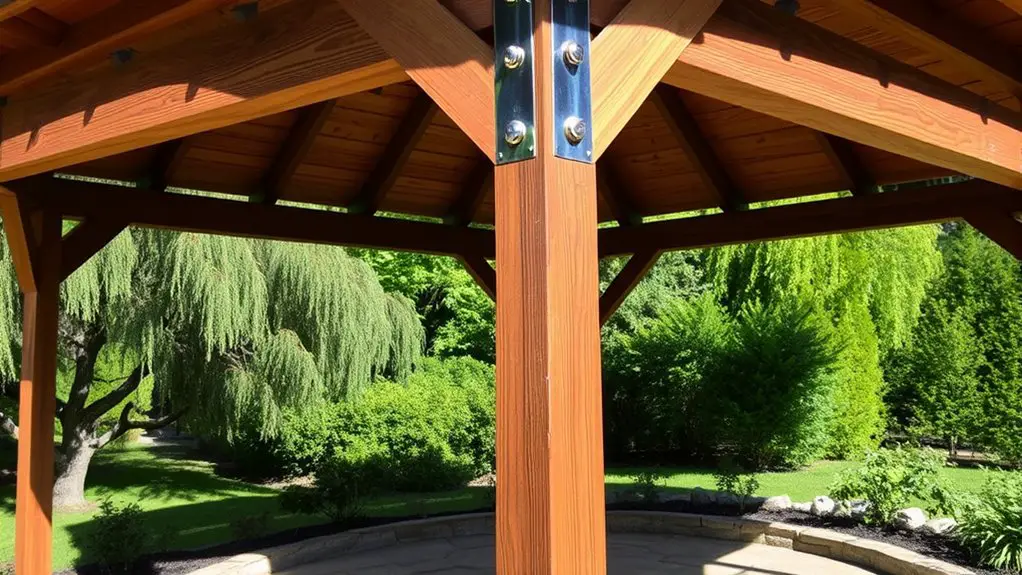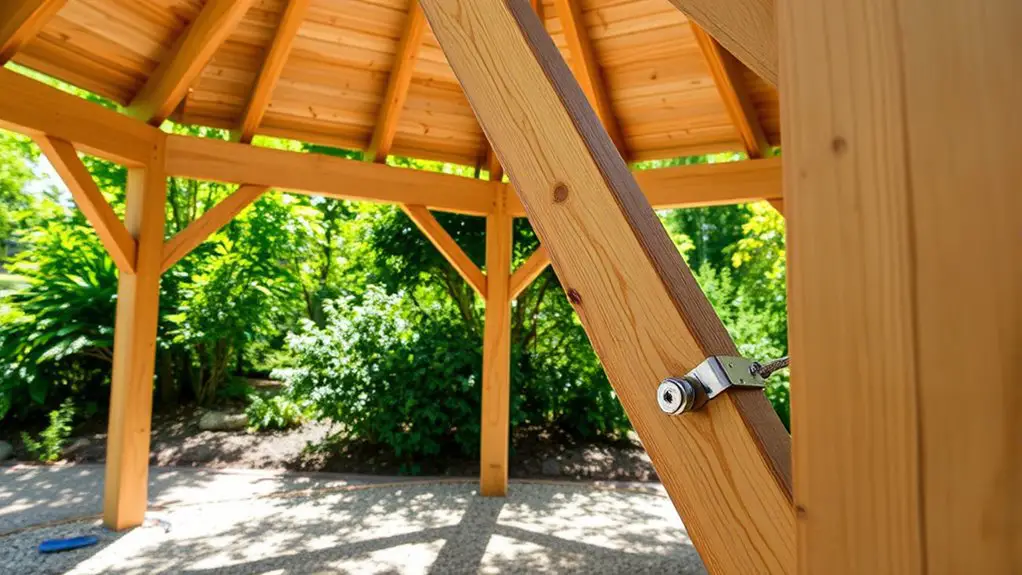To reinforce your DIY gazebo for extra stability, start by selecting high-grade timber and quality fasteners. Strengthen the foundation with concrete or gravel, ensuring it’s well-compacted. Add cross bracing and diagonal supports for effective force distribution. Secure roof connections with strong brackets and regular inspections to prevent deterioration. Consider using wind brackets for added protection. Maintaining these elements will enhance your structure’s longevity, and there are more techniques to discuss for increasing durability and resilience.
Choosing the Right Materials for Reinforcement

When you’re reinforcing a DIY gazebo, selecting the right materials is essential to ensuring long-term stability and durability. The wood selection is a critical factor; opt for high-grade timber like cedar or redwood, known for their natural resistance to decay and insects. These materials not only enhance aesthetics but also provide superior structural integrity.
Consider the environmental conditions your gazebo will face. For instance, if you live in a humid area, prioritize wood treated for moisture resistance. This enhances material durability, ensuring your structure withstands the elements over time. Additionally, using quality fasteners and connectors made from galvanized steel can greatly improve the overall stability of your gazebo, preventing rust and corrosion.
Incorporating high-quality wood into your design not only boosts durability but also adds charm to your outdoor space.
Taking the time to choose the right materials empowers you to create a resilient outdoor space that aligns with your desire for freedom and enjoyment in nature.
Strengthening the Foundation
To strengthen your gazebo’s foundation, you need to select the right materials and guarantee proper ground preparation. The choice of materials, such as concrete or gravel, will considerably impact stability and longevity. Additionally, adequately preparing the ground by leveling and compacting it is essential to support the structure effectively. A well-constructed foundation not only enhances durability of the gazebo but also provides a stable base for the entire structure.
Choosing the Right Materials
Choosing the right materials for your gazebo’s foundation is essential for guaranteeing long-term stability and durability. You’ll need to assess both natural materials and synthetic options to find the best choice for your needs. Consider the following factors:
- Strength: Verify materials can withstand weather elements and weight.
- Durability: Choose options that resist decay, pests, and corrosion.
- Cost: Factor in your budget while evaluating performance and longevity.
- Environmental Impact: Opt for sustainable materials if you’re eco-conscious.
Natural materials like treated wood offer aesthetic appeal but may require more maintenance, while synthetic options like composite materials provide durability with less upkeep. Weigh these elements carefully to create a solid foundation for your gazebo.
Proper Ground Preparation
Proper ground preparation is essential for ensuring your gazebo’s foundation remains stable over time. Start by evaluating your site’s soil conditions, as they directly influence stability. Utilize effective soil compaction techniques, such as tamping or utilizing a plate compactor, to enhance soil density and minimize settling. This step is vital for creating a solid base. Additionally, implement drainage solutions to divert water away from the gazebo site, preventing erosion and maintaining foundation integrity. You can achieve this by installing trenches or French drains to manage water flow. By meticulously preparing the ground, you’ll not only enhance your gazebo’s stability but also enjoy a more durable structure that stands the test of time. Take these steps for long-lasting freedom in your outdoor space.
Adding Cross Bracing

Although many DIY gazebo projects focus on aesthetics, adding cross bracing is crucial for enhancing structural stability. Cross bracing techniques help distribute loads and resist lateral forces, guaranteeing your gazebo withstands wind and weather. To effectively implement cross bracing, consider these steps:
- Choose Effective Materials: Use sturdy wood or metal for maximum durability.
- Select Locations: Position braces diagonally across the frame to maximize strength.
- Secure Connections: Make sure all connections are tightly fastened using bolts or screws, avoiding any looseness.
- Test Stability: After installation, gently push on the structure to check for movement; make adjustments as needed.
Incorporating cross bracing not only bolsters your gazebo’s resilience but also empowers you to enjoy your outdoor space with confidence, free from worry about structural failures. Additionally, implementing multiple securing methods can further enhance your gazebo’s ability to withstand harsh winds.
Installing Diagonal Supports
When installing diagonal supports, you need to take into account the appropriate support material for ideal strength and durability. Proper placement techniques are essential to guarantee that the supports effectively enhance the gazebo’s stability. Additionally, having the right installation tools on hand will streamline the process and improve the overall structural integrity of your project. Anchoring methods such as metal stakes or auger-style anchors can further reinforce your gazebo’s stability.
Choosing Support Material
Choosing the right support material for diagonal braces is essential for enhancing the stability of your DIY gazebo. You’ll want to take into account various support types and their material durability to guarantee lasting performance. Here are four key materials to evaluate:
- Steel: Offers excellent strength and resistance to bending, ideal for heavy loads.
- Aluminum: Lightweight and resistant to rust, making it a practical choice for mobility.
- Wood: Aesthetic appeal and decent durability when treated; however, it may require regular maintenance.
- Composite materials: Combine the benefits of wood and plastic, providing durability without the weight.
Selecting the right material not only reinforces the structure but also aligns with your vision for a stable, enduring gazebo.
Placement Techniques Explained
After selecting the appropriate support materials, the next step is ensuring their effective installation for maximum stability. Installing diagonal supports is essential, as they enhance structural integrity by distributing forces evenly. Utilize placement strategies that focus on ideal locations, typically at the corners and midpoints of each side. Position the diagonal supports in a way that forms an ‘X’ shape, connecting the upper corners of the posts to the lower opposite corners. This configuration efficiently counters lateral forces, such as wind. Make sure the supports are securely fastened using appropriate hardware, ensuring they’re flush against the gazebo structure. By following these guidelines, you’ll achieve a robust and reliable framework that allows for the freedom to enjoy your gazebo without concern.
Installation Tools Needed
To install diagonal supports effectively, you’ll need a few essential tools that guarantee precision and durability. Your tool selection plays an important role in achieving a stable structure. Here’s what you should have:
- Drill – For making pilot holes and driving screws.
- Screwdriver Set – Including various screw types to confirm compatibility with your materials.
- Measuring Tape – For accurate measurements and confirming proper angles.
- Level – To check that your supports are perfectly vertical and horizontal.
With these tools, you’ll enhance the stability of your gazebo. By focusing on the right screw types and confirming a strong connection, you’re not just building; you’re creating a lasting space for freedom and enjoyment.
Securing Roof Connections
While you may have successfully constructed the frame of your DIY gazebo, securing the roof connections is vital for guaranteeing long-term stability and weather resistance. Start by employing effective roof connection techniques, which include using strong brackets and quality fasteners designed for outdoor use. These components are significant for reinforcing the structure and minimizing movement during adverse weather conditions.
When securing joints, be meticulous with your measurements and alignments. Ascertain that all connections are tight and flush, as any gaps can weaken the overall integrity of the roof. For added strength, consider using diagonal bracing at key junctions; this can help distribute forces more evenly across the structure. Additionally, using waterproof coatings on the roof will enhance its resistance to rain and moisture.
Don’t overlook the importance of regular inspections. Over time, wear and tear may compromise your connections, so staying proactive will enhance the longevity of your gazebo. A secure roof guarantees you can enjoy your outdoor space without worry.
Using Wind Brackets

Incorporating wind brackets into your DIY gazebo design can greatly enhance its resilience against strong gusts and unpredictable weather. Understanding the different wind bracket types and proper installation techniques is crucial for maximizing stability.
Here are key considerations when using wind brackets:
- Choose the Right Type: Select from L-brackets, T-brackets, or corner brackets, based on your gazebo’s design and structural needs.
- Strategic Placement: Position brackets at critical connection points, such as where the roof meets the walls, to provide ideal support.
- Secure Fasteners: Use corrosion-resistant screws or bolts to guarantee durability, especially in adverse weather conditions.
- Regular Inspections: Check your brackets periodically for wear or loosening, making adjustments as needed to maintain structural integrity. Additionally, ensure that you secure your gazebo using anchoring techniques to prevent it from being lifted by strong winds.
Anchoring the Gazebo
Although you may have reinforced your DIY gazebo with wind brackets, proper anchoring is equally essential for guaranteeing stability. The success of your anchor system largely depends on the anchor types you choose and the soil evaluation you conduct. Start by evaluating your soil conditions—sandy soil often requires different anchor types than clay or loamy soil. For sandy soil, consider using auger anchors, which provide excellent grip. In contrast, for clayey soils, concrete or helical anchors may offer superior stability.
You’ll need to install these anchors at a sufficient depth to resist uplift forces, particularly in windy conditions. In addition, it’s important to choose anchors based on wind resistance to ensure that your gazebo can withstand adverse weather conditions. Confirm that the anchors are securely fastened to the gazebo structure, using appropriate hardware to prevent loosening over time. By effectively combining the right anchor types with a thorough soil evaluation, you’ll enhance your gazebo’s resilience and stability, allowing you to enjoy your outdoor space without worry.
Regular Maintenance and Inspections
To guarantee your DIY gazebo remains stable and functional over time, regular maintenance and inspections are essential. Implementing routine upkeep and seasonal checks can prevent structural issues and secure longevity. Here’s a concise checklist to guide you:
- Inspect Fasteners: Check screws, bolts, and nails for rust or looseness, tightening or replacing as necessary.
- Examine Frame Integrity: Look for signs of rot or damage in wooden components, and address any weak spots promptly.
- Assess Canopy Condition: Confirm the fabric is intact and free of mold or UV damage; replace if needed.
- Clear Debris: Remove leaves and debris from the roof and gutters to prevent water accumulation and structural stress. Additionally, maintain a maintenance log to track repairs and upkeep effectively.
Frequently Asked Questions
Can I Reinforce My Gazebo With Materials From My Local Hardware Store?
Yes, you can reinforce your gazebo using various hardware options from your local store. Consider reinforcement techniques like adding brackets, using stronger fasteners, or installing diagonal braces for enhanced stability and structural integrity.
How Often Should I Inspect My Gazebo for Stability?
You should conduct inspections at least twice a year. Look for stability signs like rust, cracks, or loose connections. Regular checks guarantee your gazebo remains safe and sturdy, enhancing your freedom to enjoy it worry-free.
What Tools Do I Need for Reinforcement?
For effective reinforcement techniques, you’ll need basic tools like a drill, screws, saw, and level. Additionally, consider structural materials such as brackets, cross beams, and anchors to enhance stability and guarantee your gazebo withstands various conditions.
Is It Necessary to Hire a Professional for Reinforcement?
While hiring a professional for reinforcement might seem like a safety net, you can achieve effective DIY reinforcement with the right tools and knowledge. It’s about balancing confidence and caution in your improvement journey.
Can Weather Conditions Affect My Gazebo’s Stability?
Yes, weather conditions can greatly affect your gazebo’s stability. Strong winds test its wind resistance, while seasonal maintenance guarantees structural integrity. Regular checks and reinforcements can help you maintain its resilience against nature’s forces.

